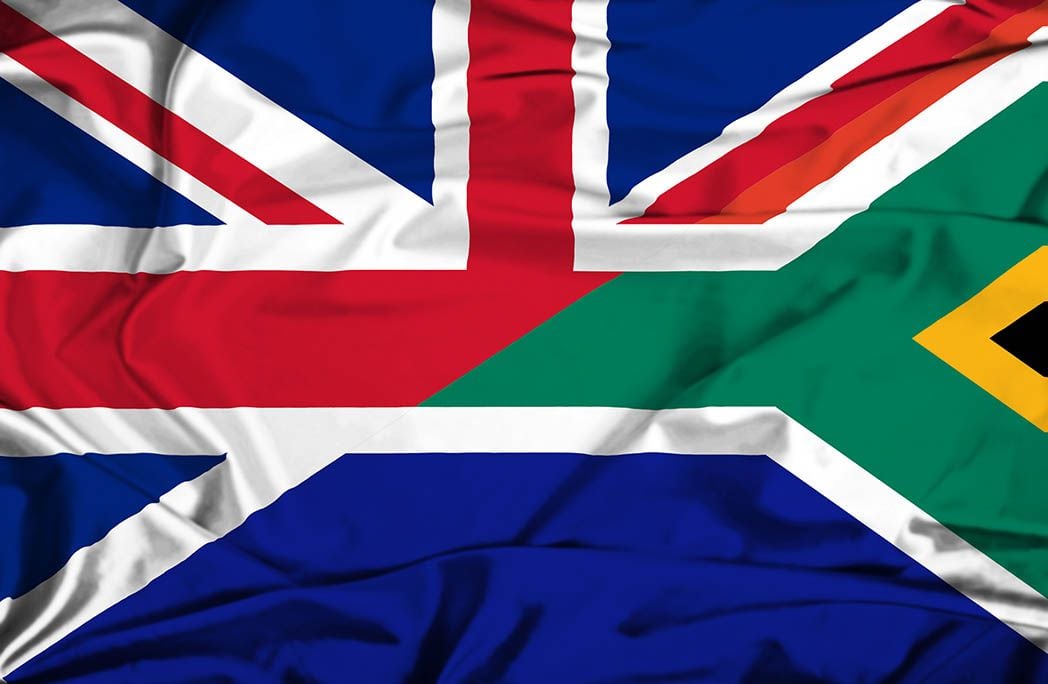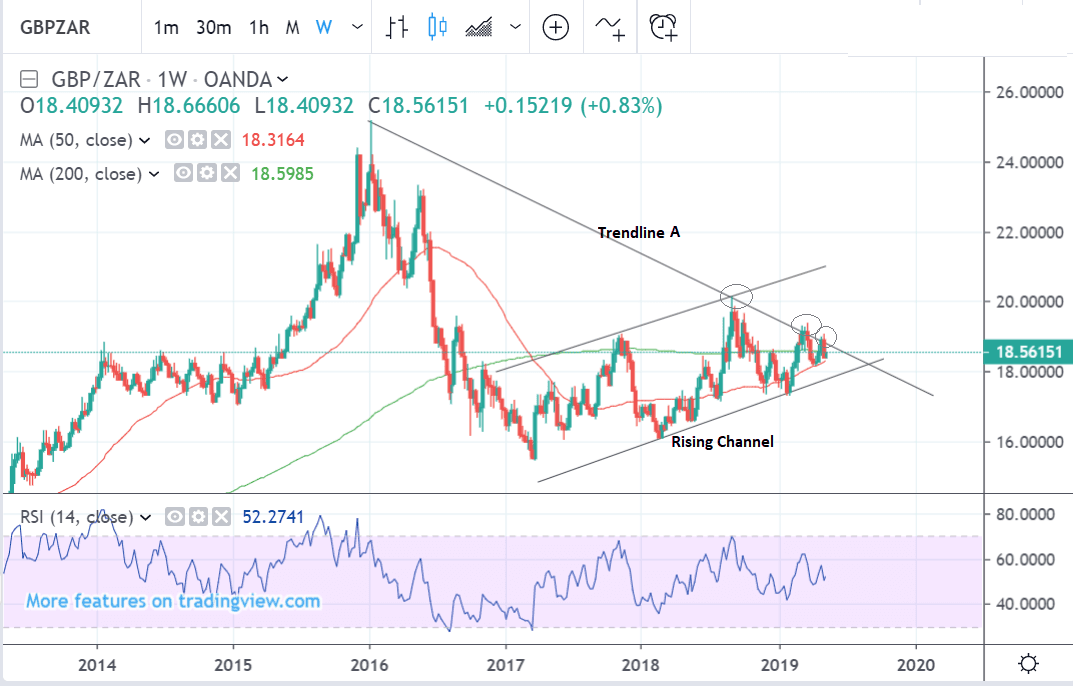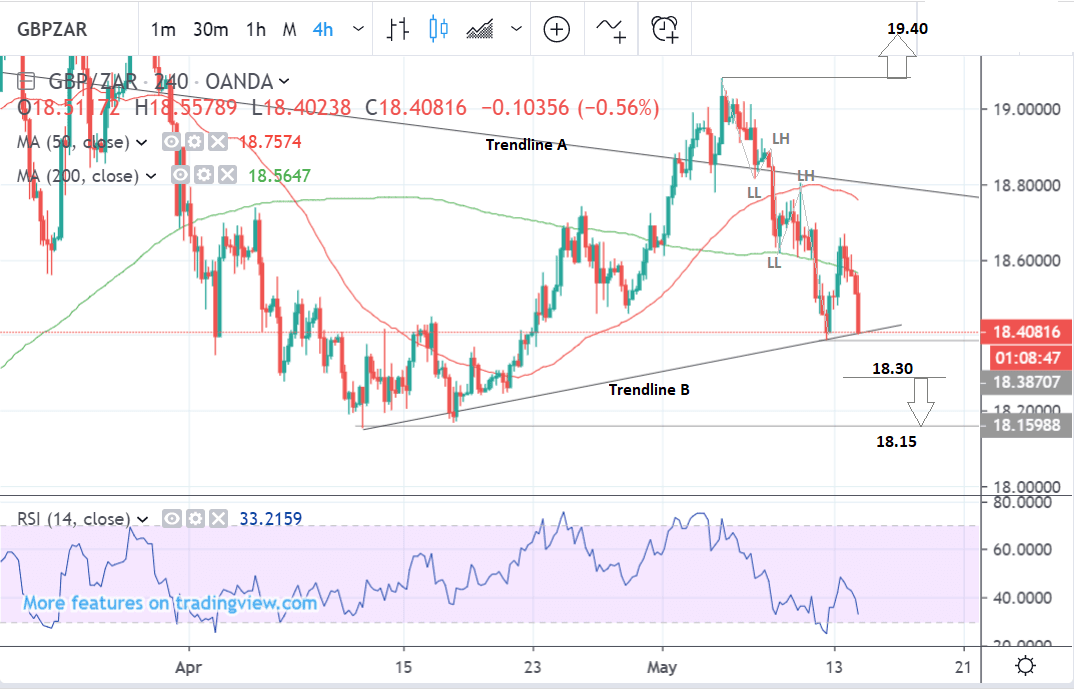South African Rand Could be Turning the Tables on the Pound

Image © Adobe Images
- Pound advance rejected at multi-year trendline again
- Possibility new downtrend is beginning
- Rand strength as political risks fade post-elections
- Global risk trends key for Rand outlook
The Pound-to-South African Rand rate is trading at 18.40 at the time of writing, after giving back most of Monday’s gains, despite markets remaining in risk-off mode as a result of an escalation in the trade war between the U.S. and China.
From a technical perspective, the bigger picture shows the pair rising up in a channel since 2017 but then repeatedly hitting a stonewall of resistance (circled) from a major trendline drawn from the 2015 highs (trendline A).
The same fate befell the most recent rally during April which at first looked like it was going to break clear of the trendline and usher in a more bullish environment but then turned around and began to decline.
After stalling and reversing at 19.0000, GBP/ZAR fell back down below the trendline and has fallen sharply since in May. The question now is whether this is the start of a deeper move lower or merely a pull-back before another leg higher.
The pair has fallen to quite robust support from the 200-day moving average (MA) and the trendline drawn from the February lows (trendline B). Whilst it rose on Monday from this solid double line of support, it has since fallen back down, although without yet breaking clearly below them.
The four-hour chart above suggests a more bearish outlook than that of the longer-term charts. The pair has established a peak and trough sequence of two sets of lower lows (LL) and lower highs (LH) and this is one of the first pieces of evidence that a new short-term downtrend is beginning.
Yet taken together with the evidence from the daily chart which suggests a tough layer of support underpinning the 18.38 lows the bearish 4hr chart signals need to be considered with a dose of caution, and we would first want to see a move well below trendline B and the MA for confirmation of a clear breakdown before forecasting a continuation of the downtrend.
Confirmation of a such a break would probably come from a breach of 18.30, which would then probably lead to a continuation down to a target at 18.15 and the key April lows. Such a move could happen during the next 10 days.
Time to move your money? Get 3-5% more currency than your bank would offer by using the services of foreign exchange specialists at RationalFX. A specialist broker can deliver you an exchange rate closer to the real market rate, thereby saving you substantial quantities of currency. Find out more here.
* Advertisement
The South African Rand: What to Watch
The general election in SA last week ended up with a win for the ANC and President Cyril Ramaphosa. The party got 58% of the vote which was just under the 60% level some analysts had said was necessary to provide Ramaphosa with the mandate to impose the necessary reforms to rebuild the economy.
The next stage will be implementation, in which markets will be watching to see whether Ramaphosa goes through with his promises to root out corruption in the party and state-owned entities as well as introduce other economic reforms.
If he is seen to be following through robustly it should support the Rand broadly speaking.
Being an emerging market (EM) currency, the Rand is heavily influenced by global investor risk trends including those related to the ongoing trade dispute between China and the U.S.
The relationship recently worsened after both countries raised even higher tariffs on each other’s exports.
The fallout is expected to hit global growth and impact especially on EM countries like SA.
From a domestic data perspective, the next key release will be retail sales data for March out on Wednesday May 15 at 12.00 BST. This is likely to be closely followed by economists as it provides a piece in the jigsaw puzzle used to estimate the growth of the economy in Q1. Current estimates are for retail sales to show a 0.5% rise compared to a year ago in March, which would be slower than the 1.1% registered in February.
SA Mining and manufacturing data out last week was better-than-expected given the many days of power cuts during the month, but it was still not good enough to avoid a decline in GDP in Q1. ABSA Bank is still forecasting a -0.3% quarter-on-quarter decline in Q1 2019 GDP.
“The March mining and manufacturing data surprised strongly to the upside, suggesting that the damage of the electricity shortages to production in March was less severe than initially feared. Seasonally adjusted output levels in both sectors increased in March relative to February. However, given the much weaker production prints in January and February, overall Q1 19 output in both mining and manufacturing still fell sharply by 12.7% and 9.1% q/q saar, respectively. Our Q1 19 GDP tracking estimate is unchanged at -0.3% q/q saar, after rounding,” says Miyelani Maluleke, an analyst at ABSA.
The other major release for the Rand is unemployment data for Q1, out on Tuesday at 10.30. In the previous quarter (Q4) the rate fell to 27.1% from 27.5%.
The result may impact on the Rand as much because of the influence it is likely to have on the mandate of the South African Reserve Bank as much as anything else. Political pressure has been increasing to have the SARB widen its remit to include ‘full employment’ like the Federal Reserve, and increases in the rate are likely to increase the pressure being exerted. The inclusion of a full employment mandate would probably lead to a rapid expansion in monetary policy with a negative impact on the Rand.
Time to move your money? Get 3-5% more currency than your bank would offer by using the services of foreign exchange specialists at RationalFX. A specialist broker can deliver you an exchange rate closer to the real market rate, thereby saving you substantial quantities of currency. Find out more here.
* Advertisement








